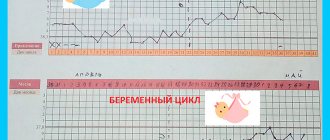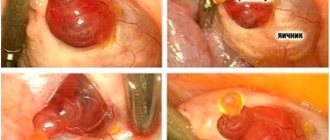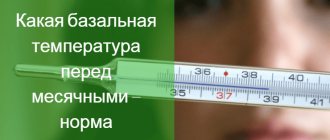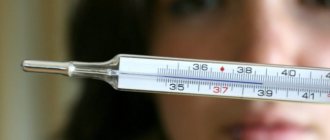What is ovulation
From a physiological point of view, ovulation is the process of maturation of an egg, its release into the fallopian tube and movement towards the uterus.
In women of reproductive age, ovulation occurs monthly. At the same time, isolated cases of absence of ovulation (1-2 times a year) are absolutely normal even for a completely healthy woman. The older the fair sex, the greater the likelihood of anovulatory (without egg maturation) cycles. In women over 45, ovulation occurs every few months. During menopause, egg maturation does not occur at all. A few days before ovulation, the level of estrogen in the blood, as well as follicle-stimulating and luteinizing hormones, gradually increases. About halfway through the cycle, the follicle (an egg surrounded by several protective layers) matures and bursts, releasing an egg. It takes from an hour to several hours to enter the fallopian tube, but its journey to the uterus will take several days. It is during this period, called ovulatory, that the egg can be fertilized. If the process of conception has occurred, after about a week the fertilized egg will attach to the wall of the uterus. In other words, for married couples planning to replenish their family, ovulation is the most favorable time for conception.
Sometimes the cycle can be anovulatory. There are quite a few reasons for the lack of ovulation. The most common cause is severe nervous tension and stress. Long flights, climate change and sudden changes in air temperature can slightly disrupt the cycle and affect the onset of ovulation. Sports associated with injuries (especially in the abdominal area) and extreme physical activity adversely affect women's health. Poor nutrition and lack of vitamins (in particular folic acid) reduce the likelihood of egg maturation.
Healthy sperm are able to maintain their mobility in a woman’s body for up to a couple of days. Therefore, in order to fertilize an egg, it is necessary to have unprotected sex 1-2 days before the expected date of ovulation, on the day of ovulation and the day after it. It is important that the male body takes some time to form new sperm and allow them to mature. Therefore, when planning a pregnancy, sexual intercourse should occur no more often than every other day.
How the graph is built
You need to take a piece of paper in the box. The X (abscissa) and Y (ordinate) axes are drawn on it. Each cell along the axes is marked as one division. X are days, Y is temperature 0.1°C. The temperature is taken as the starting point at 36.0°C for convenience. One graph will reflect one monthly cycle .
You should also draw a line at 37°C parallel to the x-axis (X). This is the temperature limit; anything higher is considered pathological. Next, points are plotted on the graph, each day opposite the recorded temperature. At the end of the month the dots are connected.
Analysis
The result is a graph that is visually divided into two parts, showing the phases of low and high temperatures. It looks something like this:
At the beginning of the cycle, the readings are approximately 36.6-36.8°C. Further, from the first day of menstruation, the temperature should normally decrease by 0.2-0.5°C.
The duration of one phase is 10-20 days.
The phases determine the duration of the cycles. The graph clearly shows the moment of ovulation - the temperature rises sharply. This means the egg is mature and ready to be released. Next, the body begins to produce progesterone to begin a possible pregnancy. The reproductive system is completely ready for conception. Thanks to this, the temperature rises even higher and remains “in readiness mode” for several days. The difference in temperature at the beginning and end of ovulation should be approximately 0.4-0.5°C.
Then the temperature drops and a new monthly cycle begins.
How to use
To make calculations more likely, you should take temperature measurements and make graphs for at least 3-4 months. Then you need to find common features in them that will help determine the most likely periods of ovulation in the future. This information will help not only plan the best time for conception, but also gender.
Usually the entire cycle lasts 28 days , and ovulation occurs on the 14th day. You are most likely to get pregnant if you conceive 12 hours before ovulation. It is difficult to predict such a moment with an accuracy of hours, which is why data for several months is needed. A gynecologist can help with the analysis.
According to research, the conception of a girl should occur 48 hours before the release of the egg . This is due to the fact that sperm from “girls” are more resilient and tenacious than from “boys”.
Tracking your health and symptoms
During ovulation, the body experiences a powerful hormonal shock. For many, it goes unnoticed, but if you observe your condition for at least 2-3 cycles, you can notice patterns in your well-being and behavior.
One of the most recognized symptoms of ovulation is the presence of spotting around the middle of the cycle. Rupture of the follicle may be accompanied by drops of blood interspersed with typical discharge or scanty brown discharge as a result of detachment of the endometrium (uterine mucosa). Often the signs of ovulation are similar to the sensations during menstruation. The discharge may be accompanied by minor pain in the lower abdomen and lower back. The nature of ovulatory pain differs among different representatives of the fair sex: it can be either pulling or stabbing. The pain is so insignificant that girls do not pay attention to it at all.
Ovulation is almost always accompanied by a viscous mucous discharge, similar in consistency to egg white. At this time, cervical discharge contributes to the most comfortable sexual intercourse and the rapid passage of the egg to the fallopian tube. In addition, the peak of hormones affects the behavior of women. At this time, biological instincts are aimed at procreation, so during ovulation there is an increase in sexual desire. Sometimes representatives of the fair sex experience sudden mood swings during this period of time, which, again, is associated with the dancing of hormone levels.
During this period, you may also experience atypical ovulatory symptoms: mild nausea, headache, bloating, too much appetite or lack of it. Each woman's body reacts to the surge of hormones differently. By noting symptoms in a notepad, calendar or special applications, you can identify individual manifestations of ovulatory syndrome in just a few cycles.
Other causes of hyperthermia
Thermometer readings up to 37 °C are considered normal. If a woman has a temperature of 36.9 °C during and after ovulation, this does not cause concern to doctors. Once the values cross the acceptable threshold, there is cause for concern. It is worth noting that we are talking specifically about axillary body temperature, which is measured in the armpit. Basal indicators, as a rule, are always higher and have no diagnostic value in determining other pathologies.
The reason that elevated temperature persists during ovulation may be:
- infectious and inflammatory diseases of various localizations;
- cold;
- intoxication of the body due to poisoning;
- indigestion;
- taking medications;
- increased physical activity;
- stress and anxiety;
- chronic fatigue;
- autonomic disorders;
- neoplasms;
- sexual contact.
It is necessary to seek medical help if additional signs of the disease are present: pain in the abdomen, bleeding from the genital tract, nausea, weakness.
In women at the time of ovulation, ovarian apoplexy may occur. When the dominant follicle opens, the lining of the reproductive gland is damaged. This is accompanied by internal bleeding, fever and is sometimes life threatening. Hyperthermia is a protective reaction of the body in response to pathology.
The content of the article
During the menstrual cycle, there is a consistent change in the functions and structure of the female reproductive system (uterus, fallopian tubes, ovaries). In a healthy woman capable of childbearing, the cycle length is about 28 days (with fluctuations of up to 5 days, both decreasing and increasing). A change in this interval is considered normal during puberty, immediately after the onset of menstruation, as well as before the onset of menopause.
Stages of the menstrual cycle:
- Proliferation, or follicular phase (from 1 to 14 days).
Under the influence of follicle-stimulating hormone, follicles mature, estrogen levels increase, and a dominant follicle is formed. At the end of the proliferative phase, ovulation occurs. It is also classified separately as the ovulatory phase.
- Secretion, or luteal phase (from 15 to 28 days).
After ovulation, the follicle turns into the corpus luteum and becomes capable of secreting estradiol and progesterone, hormones necessary to prepare the endometrium for pregnancy. Menstruation begins if pregnancy does not occur.
With the onset of ovulation, the mature follicle ruptures and the egg, or oocyte, is released from the ovary. In some cases, not one, but two or more oocytes may be released. If the menstrual cycle is regular, ovulation occurs in the second week after menstruation.
The increase in body temperature during ovulation is associated with the effects of progesterone. The most accurate data can be obtained by measuring basal temperature (determined before the start of physical activity after sleep). Axillary thermometry (in the armpit) is also performed.
Calendar method
In theory, ovulation occurs in the very middle of the cycle, so with a regular cycle it is not difficult to calculate the estimated day of egg maturation. For example, if the cycle consistently lasts 30 days, then ovulation should occur on the 15th day from the end of the previous menstruation and 15 days before the start of the next. But this is all in theory. In practice, many gynecologists claim that ideal ovulation dates are extremely rare. It can occur even at the very beginning (a week after your period) and at the very end of the cycle (10-12 days before the next period), although with less probability.
This method of tracking ovulation is not entirely reliable, and it is quite difficult to find out the exact date of egg maturation using a calendar. It can only be used as an auxiliary for other methods. For example, to know when approximately to buy and use ovulation tests.
Charting your basal body temperature
Basal body temperature is the temperature in the mouth, vagina or rectum at complete rest. To track ovulation using this method, you need to chart your basal body temperature from the very first day of your cycle. Immediately after waking up, trying not to move, you need to insert the thermometer into the vagina. It is best to use digital moisture-proof thermometers. Basal temperature rises during menstruation and during ovulation. During the maturation of the egg, there should be a temperature jump of about half a degree. At a norm of 36.7, during ovulation the temperature will reach 37.1-37.2 degrees.
Mark your temperature each day on a calendar or notepad. Using special applications or tables, you can visualize the basal temperature graph so that the jump is visible as clearly as possible. After a few cycles, you will notice patterns, understand what temperature is normal for you and on what day from the beginning of the cycle ovulation occurs.
How to decipher the graph?
When assessing the result, you need to have an idea of the phases of the menstrual cycle. Follicular can vary in duration from 7 to 22 days. It depends on the functioning of the woman’s hormonal system. Luteal is almost always 14 days +/- 2 days. To make it easier to decipher the graph, you need to draw an ovulation line, which will conditionally divide it into two parts.
Next, the general appearance of the circuit is assessed. In the second phase of the cycle, parameters should increase or remain at an elevated level after ovulation. Before the onset of menstruation, they systematically decrease. If conception occurs, the temperature remains elevated.
baby.online
Ovulation tests
The easiest way to determine the date of ovulation, which, however, will require some financial costs, is to track ovulation using special tests. Ovulation tests are ordinary strips that, unlike pregnancy tests, do not respond to the concentration of hCG (human chorionic gonadotropin), but to LH (luteinizing hormone).
The procedure for conducting an ovulation test is no different from conducting pregnancy tests. Fresh urine should be collected in a dry, sterile container, the test should be unpacked and placed in the liquid for about 5 seconds. However, you should carefully read the instructions on the package, as some tests need to be kept shorter or longer, and some do not require collecting urine in a container at all. The result is interpreted quite simply: if after a few minutes only one line appears on the test, then this is not the day of ovulation. If there is a second stripe, but it is pale, ovulation will most likely occur in the coming days. A bright second stripe is an accurate sign of ovulation.
So, there are several ways to track your fertile day. For reliability, these methods can be combined. If you cannot track ovulation within six months, you should consult a gynecologist. An ultrasound will show the most accurate results.
Measurement Rules
To obtain accurate data, measurements must be taken correctly, as other factors influence the results. Let's look at the main rules:
- It is better to choose the first day of the menstrual cycle as the starting point for starting measurements.
- Temperature measurement is carried out immediately after waking up from sleep, in the rectum (rectal).
- Before taking measurements, a person must sleep for at least 6 hours.
- It is advisable to measure the temperature at the same time every day and in the same body position (deviation no more than 30 minutes).
- Before the measurement, you should not take a shower, go to the toilet, or generally engage in physical activity (stick your head in and take your temperature).
- The measurement duration is approximately 8 minutes.
- You can use an electric and mercury thermometer, but it is better to give preference to the latter (less risk of error).
- All results should be recorded in a notebook; skipping measurements is not recommended.
- It makes no sense to measure temperature in case of colds or infectious diseases, sleep disturbances, stress, depression, climate change or overwork.
- The reliability of the results is negatively affected by the following factors: taking hormonal medications, contraceptives and sedatives, as well as alcohol and drugs.
- Having sex late at night can also affect your temperature.
Important! Temperature should be measured every day for a month or more. Based on the measurements, it will be possible to create a graph that will show the moment of the highest degree of ovulation.










